"Oppenheimer" Production Notes |
Read more at in70mm.com The 70mm Newsletter |
| Written by: Universal Pictures | Date: 26.06.2023 |
|
UNIVERSAL PICTURES Presents |
More in 70mm reading: Where to see "Oppenheimer" in the Splendour of Glorious 7OMM About "Oppenheimer" and Large Format "Oppenheimer" is Christopher Nolan's next adventure in IMAX 7OMM "Tenet" | "Dunkirk" | “Interstellar” | "Inception" "Nope" Panavison Large Format Motion Picture Systems in70mm.com's IMAX Page |
THE SYNOPSIS |
|
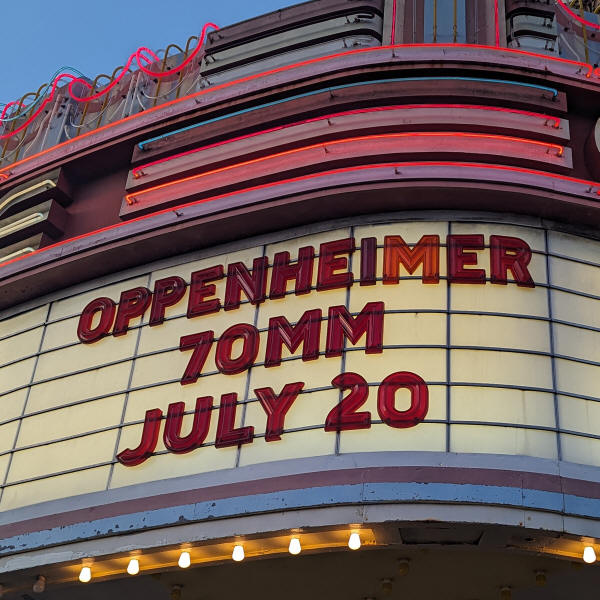 "Oppenheimer"
in 70mm at the Grand Lake in Oakland, CA. USA. Picture: Casey Foster "Oppenheimer"
in 70mm at the Grand Lake in Oakland, CA. USA. Picture: Casey FosterWritten and directed by CHRISTOPHER NOLAN, Oppenheimer is an IMAX®-shot epic thriller that thrusts audiences into the pulse-pounding paradox of the enigmatic man who must risk destroying the world in order to save it. The film stars CILLIAN MURPHY as J. Robert Oppenheimer and Golden Globe winner EMILY BLUNT as his wife, biologist and botanist Kitty Oppenheimer. Oscar® winner MATT DAMON portrays Leslie Groves, director of the Manhattan Project, and Oscar® nominee ROBERT DOWNEY, JR. plays Lewis Strauss, a founding commissioner of the U.S. Atomic Energy Commission. Academy Award® nominee FLORENCE PUGH plays psychiatrist Jean Tatlock; JOSH HARTNETT plays pioneering American nuclear scientist Ernest Lawrence; Oscar® winner CASEY AFFLECK plays Boris Pash, chief of Army counter-intelligence at the Presidio in San Francisco; Oscar® winner RAMI MALEK plays David Hill, an associate experimental physicist; and Oscar® winning filmmaker and actor KENNETH BRANAGH plays Nobel Prize winning physicist Niels Bohr. Also starring are BENNY SAFDIE (Licorice Pizza) as theoretical physicist Edward Teller, DYLAN ARNOLD (Halloween films) as Frank Oppenheimer, Robert’s younger brother; GUSTAF SKARSGÅRD (Air) as Manhattan Project member Hans Bethe; DAVID KRUMHOLTZ (The Ballad of Buster Scruggs) as Nobel Prize winning physicist Isidor Rabi; MATTHEW MODINE (The Dark Knight Rises) as Vannevar Bush, head of the U.S. Office of Scientific Research and Development; DAVID DASTMALCHIAN (Dune: Part One) as William Borden, a zealous advocate for U.S. nuclear superiority; and Oscar® nominee TOM CONTI (The Dark Knight Rises) as Albert Einstein. The cast includes, as members of the Manhattan Project, Emmy nominee MICHAEL ANGARANO (Haywire) as Robert Serber, JACK QUAID (Logan Lucky) as Richard Feynman, JOSH PECK (Red Dawn) as Kenneth Bainbridge, OLIVIA THIRLBY (Juno) as Lilli Hornig, DANE DEHAAN (Valerian and the City of a Thousand Planets) as Kenneth Nichols and DANNY DEFERRARI (Shiva Baby) as Nobel Prize winner Enrico Fermi. ALDEN EHRENREICH (Solo: A Star Wars Story) appears as a Senate Aide; JEFFERSON HALL (Tenet) plays Haakon Chevalier, a friend of Oppenheimer; JASON CLARKE (Zero Dark Thirty) plays special counsel Roger Robb; JAMES D’ARCY (Dunkirk) plays Patrick Blackett, Oppenheimer’s head tutor at Cambridge; and TONY GOLDWYN (King Richard) plays Gordon Gray, a former Secretary of the Army who chaired the 1954 committee overseeing the security clearance hearing of Oppenheimer. |
|
 "Oppenheimer"
at the Delphi cinema in Berlin, Germany. Picture by: Gerhard Witte "Oppenheimer"
at the Delphi cinema in Berlin, Germany. Picture by: Gerhard WitteThe film is based on the Pulitzer Prize-winning book American Prometheus: The Triumph and Tragedy of J. Robert Oppenheimer by KAI BIRD and the late MARTIN J. SHERWIN. The film is produced by Oscar® nominee EMMA THOMAS p.g.a. (Dunkirk, Inception), for Atlas Entertainment by Oscar® nominee CHARLES ROVEN p.g.a. (The Dark Knight trilogy, American Hustle), and CHRISTOPHER NOLAN p.g.a. Nolan’s films, including "Tenet", "Dunkirk", “Interstellar”, "Inception" and The Dark Knight trilogy, have earned more than $5 billion at the global box office and have been awarded 11 Oscars and 36 nominations, including two Best Picture nominations. Oppenheimer is filmed in a combination of IMAX® 65mm and 65mm large-format film photography including, for the first time ever, sections in IMAX® black and white analogue photography. • Go to Where to see "Oppenheimer" in the Splendour of Glorious 7OMM The director of photography is Oscar nominee HOYTE VAN HOYTEMA ASC, FSF, NSC (Dunkirk, Tenet); the production designer is RUTH DE JONG (Us, "Nope"), the costume designer is winner ELLEN MIROJNICK (Fatal Attraction, Speed), the editor is JENNIFER LAME ACE (Black Panther: Wakanda Forever, Tenet); and the music is by Academy Award® winner LUDWIG GÖRANSSON (Black Panther films, Tenet). |
|
THE BACKSTORY |
|
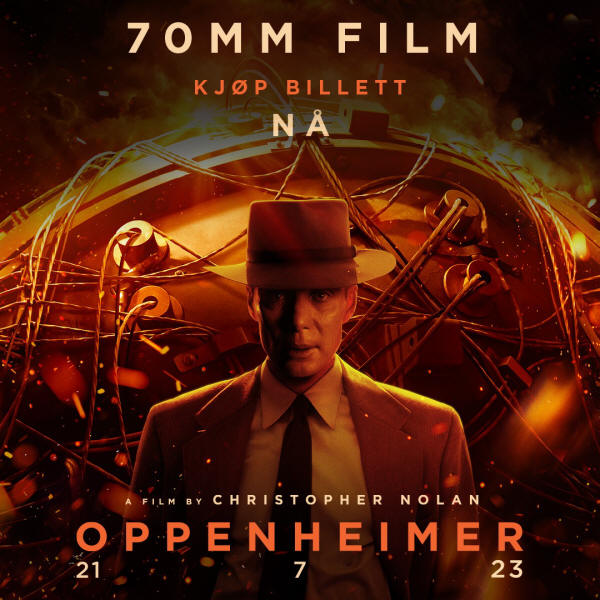 Nordisk
Film Biografer, Klingenberg in Oslo, Norway with a simple message "Buy your
ticket NOW!" Nordisk
Film Biografer, Klingenberg in Oslo, Norway with a simple message "Buy your
ticket NOW!" The films of Christopher Nolan have pushed the limits of cinematic storytelling to tell epic stories about unlikely heroes and audacious schemes that examine the necessity, morality, and hubris of ambitious endeavor. The brain-bending heist film Inception took audiences deep into the inner spaces of the dreaming mind, while his spectacular space odyssey Interstellar took them on a trippy journey into the outer limits and looping eddies of the universe. With Dunkirk, Nolan deployed multiple perspectives and time signatures to capture the harrowing experience of soldiers trying to survive the deadly and dehumanizing horrors of war, and with Tenet, he illuminated and manipulated the concepts of perspective and time to spin a metaphysical sci-fi thriller about the present under attack from the future. Each of his movies has been made with a delighted passion for the techniques of classic moviemaking while also expanding the boundaries of new tools, most notably IMAX® cameras, to reimagine the art of cinema itself. Now, the Oscar®-nominated writer-director brings to screen his most ambitious and urgent movie yet, a sweeping, epic thriller that delves deep into the psyche of a singular American mind: the brilliant scientist behind the world-shattering invention that represented the total sum of human ingenuity, an invention that would remake civilization, even as its very existence threatened the future of mankind. Inspired by the Pulitzer Prize-winning book American Prometheus by Kai Bird and Martin J. Sherwin, Oppenheimer chronicles the life and legacy of J. Robert Oppenheimer, the father of the atomic bomb.
|
|
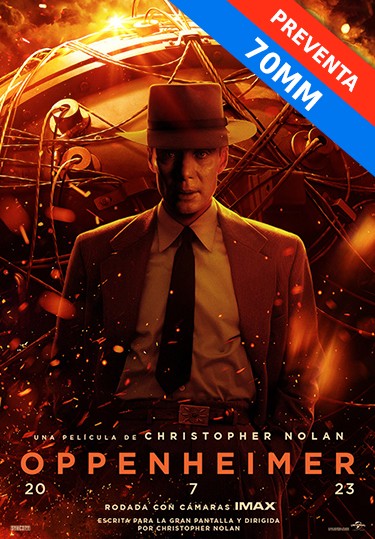 Pushing the Button Pushing the ButtonThe Creation of Oppenheimer The making of the atomic bomb was a triumph of human ingenuity that yielded learning that has seeded innovation in countless areas of science and technology. But it also commenced an arms race that has had seismic and destructive ramifications for the entire world, introducing a new existential fear into the lives of people everywhere that has not gone away. The origin of Nolan’s desire to make Oppenheimer lay in the fear that troubled the scientists of the Manhattan Project as they sought the secrets of fission to make a fusion bomb, a fear that Oppenheimer dubbed “the terrible possibility.” “In the lead-up to the Trinity test, Oppenheimer and his team were dealing with the very small possibility that when they pushed that button and triggered that first bomb, they would set fire to the atmosphere and destroy the entire planet,” Nolan says. “There was no mathematical or theoretical basis on which they could completely rule out that possibility, however small. And yet, they pushed that button, anyway. It’s an extraordinary moment in human history. I wanted to take the audience into that room and be there for that conversation, and then be there when that button is pushed. It’s just the most incredible moment, if you think about it. The risk of it. The relationship between science, theory, intellect—the things that we can imagine—versus the practical nature of bringing these abstract ideas into the real world, dealing with them as concrete realities, and all their consequences.” (Evidence of Nolan’s fascination with “the terrible possibility” can be found in his previous film, Tenet, which referenced the story.) American Prometheus became a bible that informed and guided every aspect of the Oppenheimer production. During the screenwriting phase, it provided Nolan with rich stores of insight that helped him craft what interested him most, a critical portrait of Oppenheimer that not only dramatized formative and milestone events, but also explored his psychology and interrogated the consequences of his actions. “Oppenheimer’s story is one of the great stories that there is,” Nolan says. “It’s full of paradoxes and ethical dilemmas, and that’s the kind of material I’m always interested in. While the movie tries to help the audience understand why people have done the things they’ve done, it’s at the same time asking should they have done the things they’ve done. And film, as a narrative medium, is uniquely suited to pulling an audience into a subjective experience, letting them judge things the way the characters judge them, while at the same time looking at these characters a little more objectively. At various points, we try to burrow into Oppenheimer’s psyche and take the audience on his emotional journey. That was the challenge of the film: To tell the story of a person who was involved in what was ultimately an extraordinary destructive sequence of events, but done for the right reasons, and tell it from his point of view.” |
|
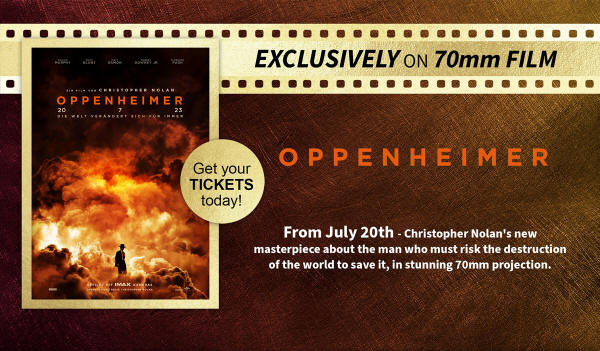 "Oppenheimer"
in "stunning 70mm projection" at the Savoy in Hamburg, Germany" "Oppenheimer"
in "stunning 70mm projection" at the Savoy in Hamburg, Germany" The story of Oppenheimer’s post-Manhattan Project years offers outside perspective on his work and legacy while also examining the motives and personalities of key individuals who impacted his life. That narrative centers on Lewis Strauss, another key player in shaping America’s nuclear policy after World War II. In 1959, President Dwight D. Eisenhower nominated Strauss to serve as Secretary of Commerce. Nolan says he typically doesn’t think too much about directorial or producorial concerns while writing scripts for fear of inhibiting his creativity. But with Oppenheimer, he felt he needed to describe, on page, for the sake of his collaborators and studio, his visual strategies for presenting a complex story that toggled continuously between subjective and objective experience, as well as two different trials happening in two different times. Nolan decided that the scenes told through Oppenheimer’s perspective would be in color (he also wrote them in the first person, an unconventional choice for a screenplay), with occasional cutaways to evocative, surreal imagery that symbolically expressed his interior world. The scenes that center on Strauss would be in black and white. “It’s a strange thing to do,” says Nolan of the unconventional choice to write in the first person. “But it made it clear to anyone who read the script that we, the audience, are on this ride with Oppenheimer. We’re looking over his shoulder, we’re in his head, we’re going everywhere with him.” Reading the script for the first time, producer Emma Thomas says she was blown away by what Nolan had conceived. “The script for Oppenheimer definitely feels like a Chris Nolan script in that he’s always been fascinated by subjectivity and objectivity, and it’s a story told from different perspectives,” Thomas says. “But on the page, he did something that I’d never seen before, which is that Oppenheimer’s parts of the story are told in the first person; it’s an incredibly effective and efficient way to describe the interior life of a character to those of us on the production, including Chris himself, who need to put it on screen. I think it’s one of the best scripts I’d ever read.” Nolan wrote the screenplay over the summer 2021. It was immediately greenlit by Universal Pictures, their first collaboration with Nolan. So began a creative mission that resembled something like the Manhattan Project itself, a group of extraordinary talents, led by a singular director, coming together in a remote section of the world (including the Los Alamos Laboratory itself) to produce a great work that would engage and test their considerable abilities. |
|
THE CHARACTERS |
|
|
Christopher Nolan’s script for Oppenheimer called for a massive cast to
play the dozens of characters representing some of the most important
movers and shakers of the 20th century. Nolan didn’t want to use
composite characters for the sake of simplifying things, feeling it was
wrong to attribute the significant, signature ideas or innovations of
one renowned figure to another. And as his characters would be moving in
and out of the story in briskly paced scenes, and sometimes, in meaty
cameos, he wanted to make sure that they popped distinctly for the
audience and stayed vivid in their mind. “Cillian Murphy playing Oppenheimer was the centerpiece of the film,” Nolan says. “But I knew that Cillian was going to need the most extraordinary ensemble around him, great actors who could challenge him and push him. In a film with so many different faces, each one had to be distinctive and credible. So, the breadth of the ensemble that casting director JOHN PAPSIDERA put together is a huge feature of the film. It’s hugely important for the audience to be able to track who’s doing what and who’s important in what way. These actors had to come to set every day with a tight, specific knowledge of their character’s role in things, what contribution they made to the Manhattan Project, what they brought to a particular meeting, experiment, or argument on a particular day. So, I was on set every day surrounded by actors who knew more than I did about what was going on, from their point of view, and that’s what you’re really looking for as a director.” |
|
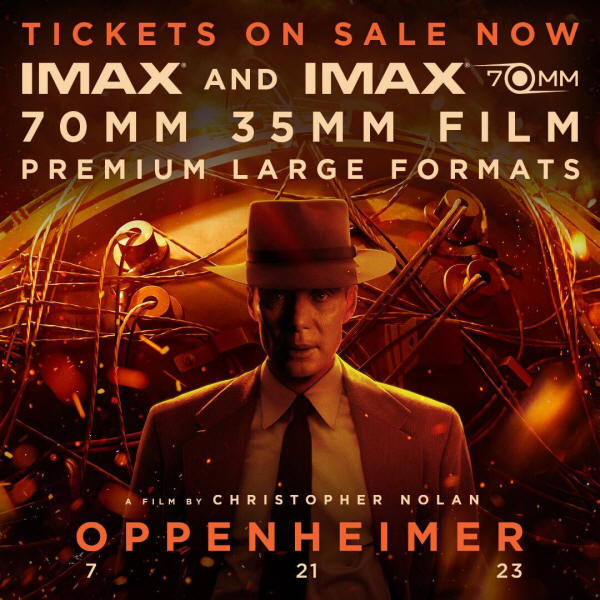 J. Robert Oppenheimer J. Robert OppenheimerCillian Murphy To embody the father of the atomic bomb, Christopher Nolan cast an actor who has appeared in five of his films (The Dark Knight Trilogy, Inception, Dunkirk), but until now, never in a lead role: Cillian Murphy, the Irish star of screen and stage whose filmography includes 28 Days Later, A Quiet Place Part II, and the global TV smash from England, Peaky Blinders. “I’ve been very fortunate to work with some remarkable actors early in their careers, and Cillian is one of them,” says Nolan. “The first time I worked with him, he was very new to things, but it was clear he had extraordinary talent, and we connected personally, professionally, and creatively. So, I’m always looking for ways to work with Cillian. It was wonderful to be able to pick up the phone and say, ‘This is it; this is the one, this is the time for you to be the lead, you get to take on a character that’s going to use every aspect of your talent and challenge you in ways you’ve never been challenged before. And he was up for that. It was really a dream come true for both of us.” For Murphy, that phone call from Nolan was unforgettable. “It’s 20 years since I first met Chris, but even at that point, I was a fan, because I had seen Memento and Insomnia,” says Murphy, whose first encounter with Nolan was auditioning for Bruce Wayne in Batman Begins, a part which ultimately went to Christian Bale. “To get to meet Chris for that movie—which, personally, I always thought was an absurd idea; me playing Batman!—was huge for me. But that meeting led to the character of Scarecrow, and an extraordinary working experience. My feeling ever since has been, if Christopher Nolan asks you to do something, no matter what the size of the part, you just turn up. I was not expecting him to call and ask me to play Oppenheimer. But he did. When I got off the phone, I just sat there rather stunned. I felt very lucky. And then we got to work.” The appeal and challenge of playing Oppenheimer, Murphy says, was doing justice to the physicist’s immense intelligence and moral struggles. “We were always chasing after the complexity of Oppenheimer, as he was no simple man,” Murphy says. “None of the people in this movie are. Having that huge intellect can be a burden; people like that operate on a completely different plane than us mere mortals, and that brings its own complications and challenges to their personal life and moral life. That was one of the trickiest things: plotting Oppenheimer’s moral journey through this story, because he’s kind of dancing between the raindrops through a lot of it, in terms of where he stands morally with his job at the Manhattan Project, and then, years after it, where he stands in terms of nuclear policy after World War II, and how his changing, evolving stances put him in conflict with other people.” To prepare for the role, Murphy read American Prometheus and several other books and watched hours of footage of Oppenheimer giving lectures and interviews. He worked with Nolan and costume designer Ellen Mirojnick to hone Oppenheimer’s distinctive look: his intense gaze, his posture, his pipe, his hat. “I’m not trying to do an impression of Robert Oppenheimer,” says Murphy. “It’s an Oppenheimer distilled from the Oppenheimer we see in historical materials and the Oppenheimer that I met in Chris’s script. It was a long process of reaching a synthesis of representation and interpretation.” Murphy consulted with renowned physicist KIP THORNE to gain insight into the profession as well as the concepts of fission. But he didn’t put pressure on himself to fully understand all the heady science and philosophy that came easy to Oppenheimer. “Most of the population can’t and don’t think about human existence, the structure of the world, and our place in the universe the way Oppenheimer did, certainly not through the lens of quantum mechanics, with its intricacies and appreciation for paradoxes,” Murphy says. “So, it would have been futile for me to spend six months trying to grasp it all. What you do is try and get the vague conceptual handle on it, then mine and extract the humanity, which is what’s most important for our film. It’s a huge story, thematically, but it’s told in a very human way. It’s not a history lesson, it’s not didactic or prescriptive, it’s not telling people ‘This is what you must learn from this.’ But it’s very clear that people can draw parallels and reflect on what’s happening in the world today in alarming ways. Filmmaking that stimulates thought and exercises you is an important part of the cinematic landscape, and I think Chris is always doing that in an interesting and provocative way.” |
|
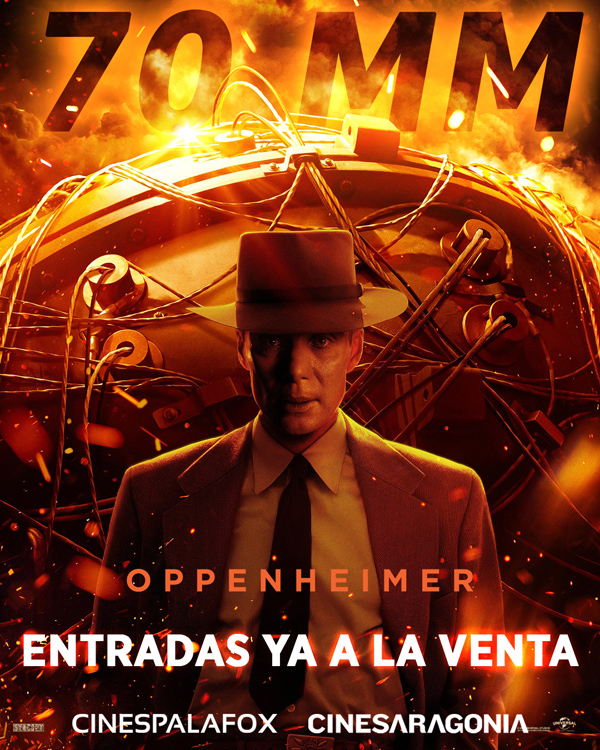 "Oppenheimer"
in Spain "Oppenheimer"
in SpainKitty Oppenheimer Emily Blunt Katherine “Kitty” Oppenheimer (née Puening), played by Emily Blunt, was a biologist, a botanist, and had married three times before she met Oppenheimer at a garden party in San Francisco. They married and had two children, Peter and Toni. During the Los Alamos years, Kitty struggled with dissatisfaction with motherhood, loneliness and addiction. Blunt was intrigued by Kitty’s rejection of social convention or expectation. “Kitty is a character who doesn’t do small talk; she only does big talk,” Blunt says. “She’s complicated, volatile, bewitching all at once. What I really was drawn to with her is that idea of a woman who refused to conform to the sort of feminine ideal of the time, why you need to get married and have children and support your man and that’s your job and that’s all you’re allowed. She just had this defiance against the system that felt so modern. I mean, Oppenheimer’s her fourth husband, and she’s, like, 29 when she meets him! I think she just wanted to blaze through life to the beat of her own drum. But I do feel that in Robert Oppenheimer she met her intellectual equal. There was genuine respect there. She was such a confidante for him and was his main ally when it came to making big decisions. He leaned on her heavily and her opinion was of paramount importance to him. She herself was a scientist, and she is that prime example of a woman of that time with a brilliant brain that kind of went to waste at the ironing board, and she suffered for it. Yet she believed in Robert, worshipped him, supported him, and was his biggest champion.” While Blunt dug deep into American Prometheus to find insight into Kitty, she says Christopher Nolan’s script, and his directing style, was all she needed to find the character. “Chris wrote an extraordinary character for me to dive into,” Blunt says. “Kitty exploded off the page to me; there was something monumental about her as a person. Chris gives you a lot of freedom, as a director, to explore the vulnerabilities of a character. If you see someone who is laced with a sort of volatility, or if she’s aggressive or she’s tough, I’m always looking for what’s underneath that, where’s it coming from, and how many things can you play in this one moment so it’s not just about anger. It’s about hurt, it’s about humiliation, it’s about exposure. All those things were there for me to find, and there was the creative freedom on the day to explore them.” Blunt says that chemistry came easy for her and Cillian Murphy, as the two actors worked together not too long ago in A Quiet Place Part II, in which their characters developed a close bond and battled demons of a different sort. “This was my second movie with Cillian, and because we’d worked together, we have an ease and a trust with each other,” Blunt says. “It was so effortless to leap into playing a married couple who are so intertwined and such kindred spirits. To be on the other side of him in a scene, someone who has no ego, no agenda, who just wants to create something good and true with you, it was an amazing experience.” |
|
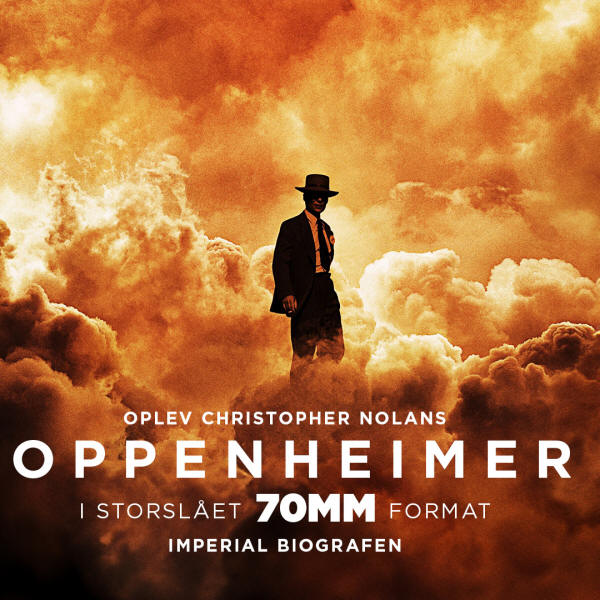 "Oppenheimer"
in "the grandeur of 70mm" at Nordisk
Film Biografer's Imperial Bio, Copenhagen, Denmark "Oppenheimer"
in "the grandeur of 70mm" at Nordisk
Film Biografer's Imperial Bio, Copenhagen, Denmark Leslie Groves Matt Damon Driven, duty-bound and abrasive, Leslie Groves, Jr. was a distinguished and trusted officer in the U.S. Army Corps. of Engineers who had just overseen construction of The Pentagon when he was given the assignment of leading the Manhattan Project. Despite differences with Oppenheimer in politics and temperament, the conservative and pragmatic Groves was immediately taken by Oppenheimer’s genius and vision and recruited him, over the doubts of many, to be his partner in the mission. Groves made significant contributions to the work of building the atomic bomb, not the least of which was his faith in Oppenheimer’s commitments amid concerns over Oppenheimer’s Communist sympathies. To play the brigadier general, the filmmakers recruited Matt Damon, who earlier this year added to a gilded resume of Oscar® nominated performances (and an Academy Award® for co-writing Good Will Hunting) with an acclaimed performance in Air, which he also produced with his friend Ben Affleck. “The relationship between Oppenheimer and Groves is a great source of enjoyment in the movie,” says Emma Thomas. “Because so much of the movie is told through Oppenheimer’s perspective, you really need someone playing Groves who can immediately bring the audience in, somebody who has that movie- star confidence, a little bit of swagger, but somebody who also feels deeply trustworthy. Matt was just the perfect guy for that. He brought so much humor and warmth to the role, and the dynamic between him and Cillian is delightful to watch.” For Damon, the appeal of working on Oppenheimer was in crafting an origin story for the world he’s known his entire life, formed from the fallout of the Manhattan Project. “I’m a child of the Cold War,” Damon says. “I grew up with the consequences of this piece of history. So, I always viewed it through that lens. What was interesting was going back and trying to understand what these guys were thinking and what was happening for them and the terrible decisions that were placed in front of them. But there’s also all this human messiness of politics, ambition, and morality tied up in the pursuit. I could also really relate to this idea of people—in this case, scientists—just wanting to know if they could do something that has never been done before. There’s that incredible natural human curiosity, fascination, and ambition of pushing to the bleeding edge, to see what can be learned, to see what would happen. And then there’s the idealism, or naivete, of some of these guys. Oppenheimer really did believe that this was going to mean the end of all war. Yet we have been living under this kind of ‘Sword of Damocles’ for my whole life and decades longer, and we often don’t think about it enough. So, without a doubt, this is one of the most important stories of our time.” Damon fleshed out the part by focusing on the essentials of Groves’ personality. “Groves had a very big ego and was not well liked by really anybody,” Damon says. “But Oppenheimer liked him; they had a certain kind of understanding and rapport. Groves never doubted what Oppenheimer did or why he did it. Groves was supremely proud of the engineering feat and the scientific significance of their efforts. There wasn’t much reflection on his part. It was just: ‘I said I was gonna do it and I did it.’ It was fascinating to play someone with that kind of certainty and focus, as well as someone who was very, very smart, but suddenly surrounded by geniuses operating on a different level—geniuses who had Groves’ same ambition but were also more conflicted about what they were doing and what might come from it.” Damon adds that it wasn’t too hard for him to connect with Groves and the fraught gambit of the Manhattan Project. Although the stakes for creating the first nuclear weapon were infinitely higher, on an interpersonal level it wasn’t that different than moviemaking. “You see so many parallels with our business,” Damon says. “The different tensions, the people who are put together who come from different worlds and have different agendas and different expectations, hopes and dreams. We all get pushed together and try to do the thing that we want to do. There’s a lot of friction and tension, as well as fission and fusion. I think that made it easier for the cast to relate to what our characters were going through.” |
|
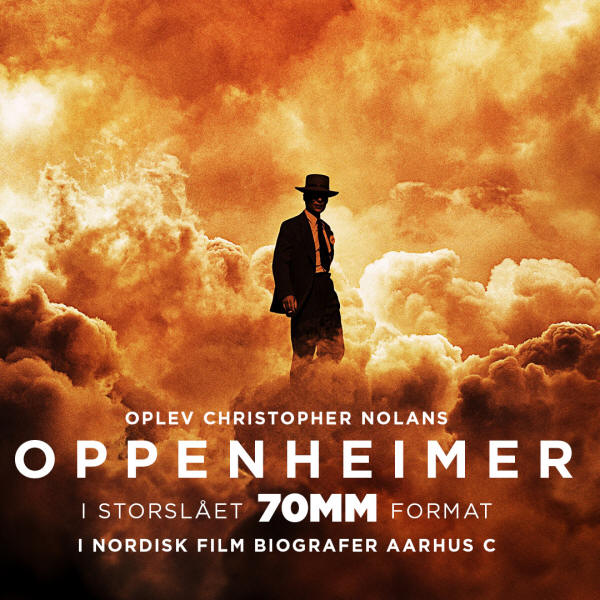 "Oppenheimer"
in "the grandeur of 70mm" at Nordisk
Film Biografer Aarhus C, Denmark "Oppenheimer"
in "the grandeur of 70mm" at Nordisk
Film Biografer Aarhus C, Denmark Lewis Strauss Robert Downey, Jr. Lewis Strauss was a founding commissioner of the Atomic Energy Commission in 1947, playing a key role in shaping America’s post-war nuclear policy. Strauss met Oppenheimer that same year in Strauss’s capacity as a trustee of the Institute of Advanced Study at Princeton University. So began a fraught relationship between two men who were both stubborn, wildly ambitious, and, in their own way, earnestly patriotic. Strauss was a Southerner, devoutly religious, a high school graduate who was always deeply insecure about his lack of formal education, a political conservative and dogmatically anti-Communist, while Oppenheimer was from the Northeast, effortlessly brilliant and highly educated, an ardent liberal with left-leaning politics. To play Strauss, Christopher Nolan and Emma Thomas approached an actor they had wanted to work with for many years, two-time Oscar® nominee (for Chaplin in 1992 and Tropic Thunder in 2009) and longtime Iron Man, Robert Downey, Jr. The Oppenheimer opportunity arrived in Downey Jr.’s life at a moment when he was trying to be choosy following his blockbuster run playing the foremost avenger of the Marvel Cinematic Universe. “I had been cooling my heels for about a year before the pandemic, just reacquainting myself with my family and other interests because I had been working super consistently,” says Downey Jr., who recently produced “Sr.”, the acclaimed documentary about his late father, the revered experimental filmmaker Robert Downey, Sr., and their relationship. “But this was Christopher Nolan, doing something that was important to him. The cast was this large gathering of folks who have their choice of projects. And just as soon as we were under way, world events lined up in a way that turned this movie into an important metaphor that could speak to any number of things. So, it was kind of a no- brainer.” The more Downey researched Strauss, and his complex relationship with Oppenheimer, the more he grew to see Strauss as a complicated figure whose world view had its merits, at least in the context of the historical moment. “I’ll give you one example,” says Downey Jr. “The Pacific Theater in World War II was so critical. Our torpedoes weren’t exploding at the right depths or distance from their targets. Strauss knew the proximity fuse would help the cause, and because he pushed for it energetically, with all his bureaucratic means, he helped shorten the war. But did anyone ever say Lewis Strauss helped shorten the war? No. Later, as he was figuring out that the Russians had atomic weapons and Strauss began advocating for H-bomb testing, which Oppenheimer opposed, Strauss did it believing it might save lives, in the same way that the innovation of the proximity fuse saved lives. His rationale isn’t as simple as ‘I need to win’ or ‘I need you to lose.’ There’s always some motivation from him where you can say, ‘Well, but he’s right.’” And as for the haircut that playing Strauss required of him, Downey Jr. didn’t flinch about it. “The funny thing about shaving back my hairline was that it reminded me of my dad, which is never a bad thing, although it did also offer my long-suffering wife a preview of the shape of things to come,” says Downey Jr. “But it was definitely right for the character. I think Chris was kind of worried or wondered if I wanted to fudge it. But that’s the last thing I would do. And all it meant was that I wore a lot of baseball caps for a while afterward.” |
|
|
Jean Tatlock Florence Pugh An intellectual, deep-feeling introvert, sensual, free-spirited, yet prone to bouts of melancholy, Jean Tatlock was a Stanford-educated psychiatrist who had an intense yet tortured romance with J. Robert Oppenheimer. To play Tatlock, the filmmakers cast Florence Pugh, whose performances in Black Widow, Midsommar and Little Women, which earned her an Oscar® nomination, have made her one of Hollywood’s brightest young stars. She took the part for the chance to work with a director she admired. “It’s a Christopher Nolan movie, number one,” says Pugh, “and number two, he has one of the most incredible leads. Cillian Murphy is an actor that I have been watching for quite some time and have been desperate to work with for ages. You’d have to be mad to say no. It felt like I was playing sports with some of the best athletes, so it was truly one of the best experiences that I’ve had.” Pugh enjoyed playing a force-of-nature personality pushing against social conventions that demeaned and limited women of that era. “Jean’s blunt and knows what she wants, and at no point is she ever punished for it, especially not by Oppenheimer,” Pugh says. “With Oppenheimer, Jean’s completely in control and in her element. Creating a woman with that much power, as well as all these other complex aspects to her, and to create her relationship with Oppenheimer in collaboration with Chris and Cillian, was itself a powerful, empowering experience and endlessly interesting.” |
|
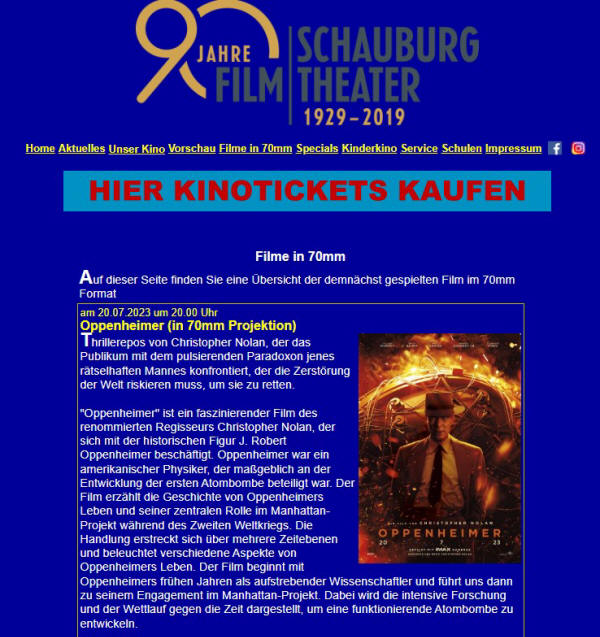 "Oppenheimer"
at Schauburg Cinerama, Karlsruhe,
Germany "Oppenheimer"
at Schauburg Cinerama, Karlsruhe,
GermanyErnest Lawrence Josh Hartnett When physicist Ernest Lawrence met Oppenheimer, they became immediate friends; Oppenheimer was drawn to Lawrence’s gregarious, extroverted personality. To play Lawrence, Nolan chose Josh Hartnett, no stranger to big films that tackle the morality of war and military heroics, having played an Army pilot in Michael Bay’s Pearl Harbor and an Army ranger in Ridley Scott’s Black Hawk Down. Returning to movies after taking time off to focus on raising kids, Hartnett re-engages the genre that made him a star through a different kind of character. “I knew a bit about Oppenheimer, but not Lawrence and how he was instrumental in creating nuclear weapons and what is now our 21st century dilemma,” Hartnett says. “He’s the most important and impressive historical figure from the 20th Century that I knew nothing about. He developed the cyclotron, developed the concept of big science, he basically gave birth to what is now the super-collider. Everything has changed because of this guy and his tinkering.” Hartnett drew inspiration from his great uncle, a physicist who worked on the Gemini space program that put Americans on the moon, and the actor consumed as much research as he could find on Lawrence. “I wanted to make sure Lawrence didn’t sound contemporary, and that he was a person of his time and place,” Hartnett says. “Luckily, I come from the same place as Lawrence. He went to school in Minnesota, and I grew up in Minnesota, so I know what people sound like there. And growing up in a family with a scientific background helped me understand a guy who was steeped in academia and had been given a long leash to push the boundaries of what was possible.” Hartnett focused his performance by emphasizing everything in Lawrence that Oppenheimer wasn’t. “One of the things I learned was that Lawrence was the kind of guy who would have been everybody’s first choice to lead the Manhattan Project. He was outgoing, he was a people person, he was good at fundraising—all these things that frankly Oppenheimer wasn’t naturally gifted at,” Hartnett says. “That helped me in getting a good perspective on the character, because the last thing I wanted to do was play Lawrence as a scientist. He’s a human being who was distinctly different than the scientists around him, most notably Oppenheimer.” Shooting on location in New Mexico was energizing for Hartnett. “When I first started filming, a significant portion of us were staying in this little hotel, which was just a bunch of cabins lined up next to each other,” Hartnett says. “After work, everybody would just come back and eat dinner together; it felt so family-like, and so unlike movies these days. It was just this massive amount of people coming together in this tiny, little place working hard to do this important film, and yet it just felt casual and easy. It was one of the best experiences of my career.” |
|
 Niels Bohr Niels BohrKenneth Branagh Winner of the 1922 Nobel Prize in Physics, Niels Bohr was revered by Oppenheimer and other scientists of his generation for his study of atomic structure and famed “Copenhagen Interpretation” of quantum mechanics. To play Bohr, Christopher Nolan turned to yet another frequent collaborator, Kenneth Branagh, who starred as the valiant Commander Bolton in Dunkirk and the villainous Andrei Sator in Tenet, and whose own storied career as a writer-director reached new heights in 2021 with Belfast, which earned him Academy Award® nominations for Best Picture and Best Director and won an Oscar® for Best Original Screenplay. “It was nice to have a starting point,” says Branagh of Nolan’s latest assignment for him. “Niels Bohr is a great man of science, Nobel laureate, one of the architects of this shift from classical physics to quantum physics, which was all part of the worldwide movement towards the knowledge that brought the atomic bomb, nuclear energy, and everything that came with it. There’s a voluminous amount of material out there about him. You can hear him; you can see him; you can watch him, and you can read a great deal about him. It was the little details that I cherry-picked that helped the most. Bohr loved football. His brother played for the Danish national team, and he was a pretty good footballer himself. He was always an outdoors guy. When he came to Los Alamos, he skied. He loved American silent Westerns of the 1920s. And he was also, reported by those who watched him, entirely absent-minded. He was an exceptionally brilliant man who could tangle with Einstein and a very approachable everyman. He might get lost crossing the street, yet his mind was also sharp as a razor.” Nolan helped Branagh further focus his performance by comparing Bohr’s relationship to Oppenheimer to famous characters from a long time ago, in a galaxy far, far away. “Even though Oppenheimer didn’t necessarily spend that much time with him, Bohr was really significant to him,” says Branagh. “Chris had this idea that he had sort of an Obi-Wan-Kenobi relationship to Oppenheimer, so it was worth thinking about in those terms. Bohr was, in a way, a magician, someone who understood some degrees more than what Oppenheimer understood. But Bohr also appreciated that Oppenheimer was the man who would be presenting the atomic bomb to the world. He recognized that Oppenheimer would be able to both understand the science and endure the trials and tribulations of what would follow, which is something that Bohr intuits is going to be necessary.” Branagh says he’s continuously amazed at Nolan’s ability to lead his cast and crew in producing such ambitious, high-risk, high-reward movies. “It’s thrilling to work with someone who is so naturally, as a filmmaker, confident in all the right ways,” Branagh says. “Chris leads the charge with an extraordinary work ethic. He’s always fun, he’s got a sharp sense of humor, he’s kind and listens to his actors. He’s a tremendous collaborator and a great natural leader. It’s a marvelous thing to be able to watch and support him.” |
|
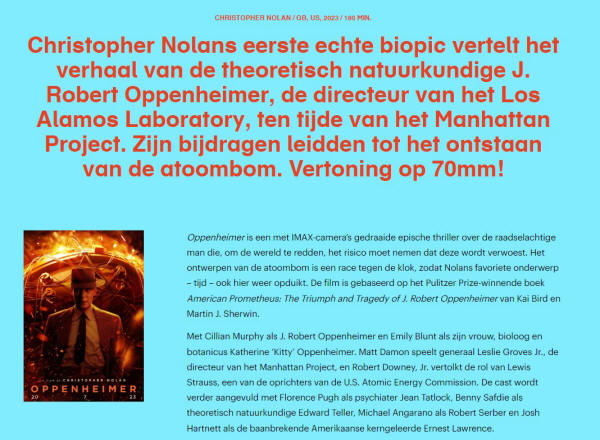 "Oppenheimer"
at the EYE, Amsterdam, Holland "Oppenheimer"
at the EYE, Amsterdam, HollandEdward Teller Benny Safdie As Oppenheimer was dubbed “the father of the atomic bomb,” Edward Teller is known for being “the father of the hydrogen bomb.” Working under Oppenheimer as they sought to crack the secrets of fission, Teller struggled to be a team player and often worked apart from his colleagues to chase his own goals. He clashed with his boss over focus—he believed they should pursue the more difficult goal of building more powerful hydrogen bombs. Even as he urged his colleague to develop the strongest possible thermonuclear weapons, it was Teller who first speculated about “the terrible possibility” that frightened Oppenheimer, the potential for setting the Earth’s atmosphere on fire. To play Teller, Christopher Nolan chose Benny Safdie, who has appeared in such movies as Licorice Pizza and Are You There, God? It’s Me, Margaret? Oppenheimer presented Safdie with an opportunity to explore a path not taken. “I almost became a physicist; I was like this close,” Safdie says. “There was a moment in my life where it was like, ‘movies or physics.’ I chose movies, but all through high school, I was learning about the standard model and quantum mechanics. I was studying with a teacher at Columbia University and visiting major laboratories, all the things one does when seriously thinking about becoming a physicist. So, it was kind of insane that Chris asked me to do this. It was an amazing confluence of my own interests.” Safdie was fascinated by the mix of genius and vanity in Teller, and how even amid the seemingly heroic mission of the Manhattan Project, personal foibles and frailties threatened to undermine the work. “The movie is very true to the science, but also to each scientist,” Safdie says. “Each one is such a character, with these complex personalities and extraordinary achievements. It’s amazing that there was a period where they all worked in the same room. They were all there for the same thing, to chase the same goal, but they did not check their egos at the door, which is part of what makes it so interesting. There is also a quality of mutual respect that is unique to this time, even between Oppenheimer and Teller, to some extent. It’s nice to see that play out too in the movie, too.” Like every member of the Manhattan Project supporting cast, Safdie was supplied with film of his real-life counterpart to get a bead on the voice, mannerisms and personality of his character. “The thing about so much of the film we have of these scientists is that they’re lecturing or explaining things, so they’re performing for each other or for students,” Safdie says. “They’re smart people trying to be smart and showing off. And Teller had this big kind of bravado when he spoke, with all these pauses and motions. But there was this one clip where he talks about his friend John von Neumann, a mathematician and physicist, and he gets kind of soft and subtle. I was like, okay, this is the key to the voice. From there, it was a matter of like fine-tuning the subtleties, like his slight lisp and his tone, or adjusting and modifying the voice for the scenes when he’s older.” For Safdie, one of the pleasures of working on Oppenheimer was watching a fellow director at work, specifically one who typically works on a size and scale larger than Safdie’s own movies. “We shot this sequence set at a party with 100 people,” says Safdie. “We had to shoot three or four scenes in the party before going to a different location to do a whole other scene. It was a big day of work, and Chris just banged it out, bam, bam, bam, bam. That was insanely impressive to see on something as big as this. And inspiring, too. Chris moved with a speed and efficiency, but more importantly, and more subtly, a confidence that allows him to play and get exactly what he needs from everyone in the time we have together. The door closes on the room, and everybody knows that we’re all in it, working together to figure things out on the fly. It was great to be a part of and fun to see.” |
|
|
Frank Oppenheimer Dylan Arnold Robert Oppenheimer’s younger brother, Frank Oppenheimer, a particle physicist, was recruited by Robert to work on the Manhattan Project. To play Frank, Nolan chose Dylan Arnold (the recent Halloween films). But Arnold didn’t know for sure who he might be playing until after his second audition. Like most of the actors who were cast as Manhattan Project scientists, Arnold auditioned by first reading a monologue about black holes that wasn’t attributed to any character. “Then, when I got called back, I was told it was the younger brother of one of the main characters,” says Arnold. “By that time, I was really hoping to be part of the film, and I was doing all the research I could about Oppenheimer. I knew Robert had a younger brother named Frank, so I just assumed I was auditioning for that guy, so I played to that.” Arnold further prepared for the work by speaking with Frank Oppenheimer’s son, Michael, and researching Frank’s relationship with Robert. “I read a lot about Frank,” Arnold says. “Watched a few videos. There isn’t a ton of stuff out there on him. However, it was very easy to prepare and do the research because I found him endlessly fascinating. Frank was all about curiosity, always trying to explore and tinker. When he was 16, he took apart his father’s piano just to see how it was built, then put it back together before his father got home. And these two brothers had a fascinating relationship. They started becoming close when Frank entered his teenage years and became interested in physics. But then later, as adults, they kind of drifted apart, in large part, because of Frank’s politics. Frank was someone who did what he felt was right and was willing to accept the consequences whatever they were. At the time, he felt that joining the Communist party was the right thing to do because it was the antithesis of fascism, which was sweeping across the world. So, to him, that seemed like the logical answer.” Arnold says it was particularly meaningful to shoot in the same remote regions of New Mexico that meant so much to Frank and Robert as children, and then as adults working on the Manhattan Project. “Being on location was really powerful,” Arnold says. “Chris doesn’t allow phones on set, too, and since the New Mexico scenes takes place in the 1940s, when obviously nobody had a cell phone, it really placed me in the mindset of what it would be like to be out there and spend your time in the canyons, riding up the side of a mountain on a horse, dealing with wind and rain and the elements, away from everyone. It felt magical. As an actor it does a lot of the work for you. You don’t have to look at a green screen, you don’t have to imagine all this stuff, to put yourself in a different place and time. You’re there.” |
|
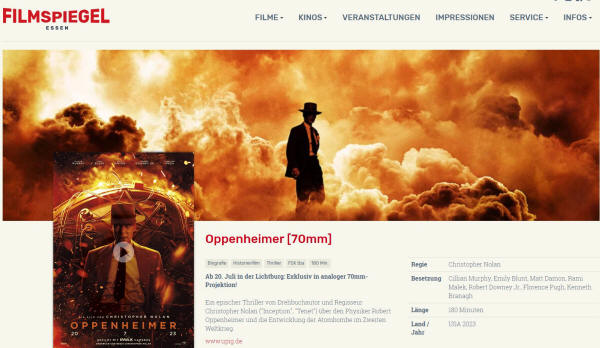 "Oppenheimer"
in Essen, Germany "Oppenheimer"
in Essen, GermanyHans Bethe Gustaf Skarsgård Hans Bethe headed the theoretical division of the Manhattan Project and developed the design for the bombs detonated at Trinity and Nagasaki. To play Bethe, Christopher Nolan chose Gustaf Skarsgård, an acclaimed Swedish actor, known throughout the world for the TV show Vikings and Ben Affleck’s recent directorial effort, Air. “I had the benefit of having so much material to look at to prepare,” Skarsgård says. “There’s a whole series of YouTube videos where Hans tells pretty much his whole life story and his whole experience of working with Oppenheimer and the Manhattan Project. It provided a template I could draw from. Still, I didn’t want to imitate the man. I wanted to bring a flavor of this person to the scenes, and understanding what and who the scenes are about, gauging how much of that flavor to bring.” Like Matt Damon, Skarsgård says he was drawn to Oppenheimer because of how it resonated with him personally, having come of age with the fear of nuclear war, and because it begs questions about our future, as well. “We are living in a world that was created as a direct consequence of the Manhattan Project,” Skarsgård says. “I grew up in the 1980s in Sweden, right next door to the Soviet Union, and I remember we had to do safety drills in bunkers under our school. That was the reality then, and now we must worry if we’re going back to that.” |
|
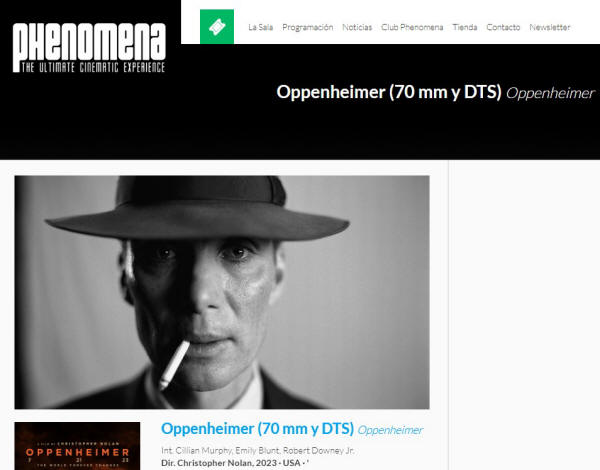 "Oppenheimer"
in Barcelona, Spain "Oppenheimer"
in Barcelona, SpainIsidor Rabi David Krumholtz Robert Oppenheimer tried to recruit his friend Isidor Isaac Rabi to the Manhattan Project—Rabi was distinguishing himself in the fields of nuclear physics and chemistry—but Rabi declined an official role. He didn’t want to move to Los Alamos, and he had personal and moral objections to the endeavor of making bombs. But Rabi did support Oppenheimer by working as a consultant, and he was there, with Oppenheimer, for the Trinity test. To play Rabi, Nolan called on David Krumholtz, who had captured Nolan’s attention many years earlier during the actor’s acclaimed performance on the CBS drama Numb3rs as a math prodigy who solves crimes for the FBI. “Many years ago, I met Chris while I was doing Numb3s and he told me he liked my work on it,” says Krumholtz, whose considerable work on stage and screen includes another role that served him well for Oppenheimer, playing physicist Werner Heisenberg in Michael Frayn’s play Copenhagen. “I always kept it in the back of my mind that Chris Nolan was a fan because those kinds of fans are hard to come by. So, when the Oppenheimer opportunity came up, I thought: Score! I knew he’s seen my work and likes it, so I went to Los Angeles to audition for it. He couldn’t have been more kind, but in my audition, he said: ‘Do it again, but this time, do it like you’re driving home from this audition and you’re thinking ‘I should’ve done it another way.’ I thought: ‘I just totally blew it.’ I was depressed for about five hours, and that same day, they called and said I was in.” As he researched Isidor Rabi, Krumholtz keyed into the physicist’s spiritual qualities and what he offered Oppenheimer as a role model and ally. “I was taken aback at how down-to-earth and street-wise Rabi was,” says Krumholtz. “Rabi was this philosopher-scientist who believed science was an art form and that scientists were true artists. It made sense that he sympathized so deeply with the burden that Oppenheimer had on his shoulders, and that he could be a friend to Oppenheimer at all. There’s a certain kind of scientist archetype where they’re totally brilliant, but they have a chip missing. They have a gift of analysis, but they have social issues. Some of the film is about Robert Oppenheimer not necessarily having all the chips. He was an extreme genius, but he lacked balance in his life. But Rabi was Oppenheimer’s opposite; Rabi had extraordinary balance. I wanted to bring that sense of wisdom to the role, this old-soul quality to him, this compassion, which he showed especially to Oppenheimer. He was like a brother to him, like family.” In Oppenheimer, Krumholtz sees a timeless tale about impossible ethical conflict on a grand scale and a timely call for wiser stewardship of the Earth. “When a tough choice needs to be made between two options that are ethically questionable, you just hope you have the right people in charge making those decisions,” Krumholtz says. “Sometimes, good things can come from the choice. Rabi went on to do revolutionary work in discovering magnetic resonance, which gave us the MRI and the ability to do all sorts of wonderful things to save lives. So much good has come out of the discoveries that were needed to build the bomb, but so much destruction has come from it, too, and still can. It’s a scary world as a result, but I still have hope. I like riding the future. Hopefully, the right people end up doing the right things with the science at their disposal to save the planet.” |
|
|
Vannevar Bush Matthew Modine In 1941, Vannevar Bush was named director of the newly formed Office of Scientific Research and Development, with a broad mandate to cultivate innovation in medicine and weapons technology. Amid growing concern that other countries were developing an atom bomb, it was Bush who mobilized the military-industrial complex to enter the race to crack the code of fission. To play Bush, Christopher Nolan cast Matthew Modine, renowned for his lead role in Stanley Kubrick’s classic Full Metal Jacket and for playing a more sinister sort of scientist chasing cosmic secrets in Stranger Things. Like his co-stars Matt Damon and Gustaf Skarsgård, Modine has vivid memories of how the nuclear threat during the Cold War shaped his childhood. “There are moments, events, and sometimes people who divide time,” Modine says. “The 16th of July 1945 is an extreme example of both. The first atomic explosion at Los Alamos unleashed a monster that could never be leashed again. As a kindergartner, crawling under my school desk, I didn’t understand if this drill was a present or existential threat. Today I understand the drill was both—and ever present.” |
|
 "Oppenheimer"
at the Cinematek, Oslo, Norway "Oppenheimer"
at the Cinematek, Oslo, NorwayWilliam Borden David Dastmalchian A zealous advocate for U.S. nuclear superiority and staunchly anti-Communist, William Borden was a lawyer and scholar specializing in national security issues who became the executive director of the U.S. Congress Joint Committee on Atomic Energy. During his final months on the job in 1953, Borden became fixated on the idea that Oppenheimer was spying for the Soviet Union. To play one of Oppenheimer’s late-life antagonists, Nolan enlisted David Dastmalchian, whose extensive credits include Dune and Blade Runner 2049. “The thing that I immediately latched onto was the letter that Borden wrote to J. Edgar Hoover and the impassioned writing that he did about Oppenheimer,” Dastmalchian says. “I believe in my heart that Borden truly, truly believed that Oppenheimer was an enemy of the state and so bringing him down and stopping him from having influence over our government and military was paramount. That was a simple objective for me when I started building the character.” Dastmalchian made his first film appearance in Christopher Nolan’s The Dark Knight. “I came to that movie in such a massive state of complete anxiety, panic attack, because I had never been on a film set before,” Dastmalchian says. “But the thing that is so constant and consistent is how Chris sets you at ease as a performer. He just communicated his ideas so clearly, with such confidence, that I immediately knew I was in hands that were not only safe but were going to get the best out of me. So, as soon as I stepped onto the set of Oppenheimer, I was like, ‘Oh, there’s that feeling.’ And it’s a really good feeling as an actor.” |
|
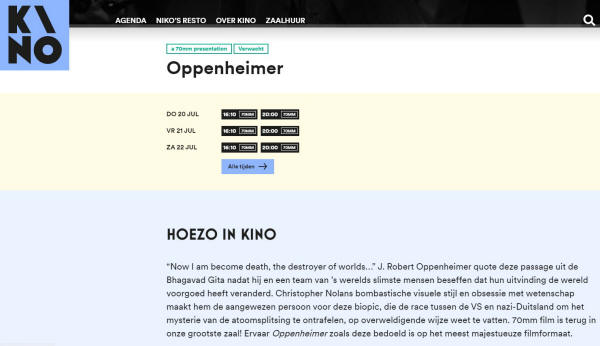 "Oppenheimer"
at the Kino, Rotterdam, Holland "Oppenheimer"
at the Kino, Rotterdam, HollandAlbert Einstein Tom Conti To play Albert Einstein, the legendary scientist whose theory of relativity was the “big bang” of the new physics, making the atomic bomb possible, Christopher Nolan cast Tom Conti, whose 60-year career on stage and screen includes a Tony Award for Whose Life Is It Anyway? in 1979 and an Oscar® nomination for Reuben, Reuben in 1983. “It’s a terrific story,” Conti says. “Most people my age know about the making of the bomb, but not everybody knows the political chicanery that surrounded the exercise, and what happened to Oppenheimer afterwards. It was a very strange situation—the government couldn’t forgive him for saving America. He’d saved their asses so by way of thanks, they tried to destroy him.” Where does one start when preparing to portray someone as iconic as Einstein? “Grow the hair and start the moustache,” says Conti with a laugh. “Having a moustache is hateful and when it comes to moustaches, Albert wasn’t a minimalist. You can’t eat soup or spaghetti and without those, life is diminished. Einstein’s accent is phenomenally important. Fortunately, it’s a sound with which I’m very familiar. Since I live in Europe, I grew up with people who spoke like him—just the accent of course. The physics? Maybe not so much.” |
|
THE PRODUCTION DESIGN AND LOCATIONS |
|
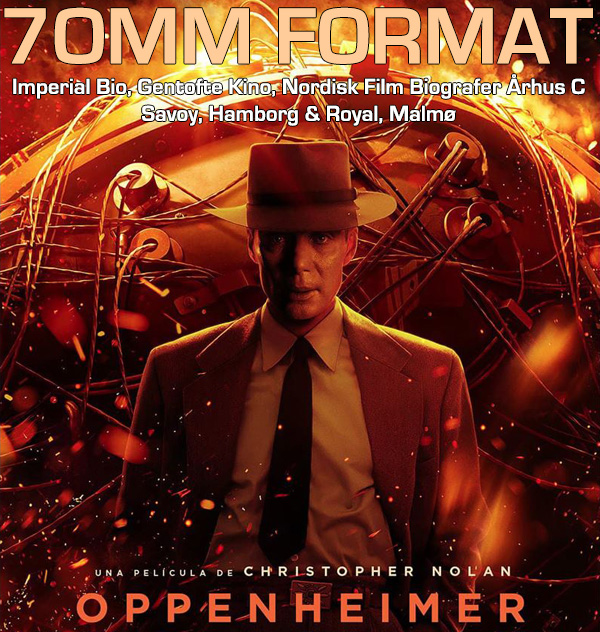 "Oppenheimer"
in 7OMM at the Imperial Bio (Cpenhagen, Denmark), Kino (Gentofte, Denmark),
Nordisk Film Biografer (Århus, Denmark), Royal (Malmø, Sweden) and the Savoy
(Hamburg, Germany) "Oppenheimer"
in 7OMM at the Imperial Bio (Cpenhagen, Denmark), Kino (Gentofte, Denmark),
Nordisk Film Biografer (Århus, Denmark), Royal (Malmø, Sweden) and the Savoy
(Hamburg, Germany)The mission of building the world of Oppenheimer was entrusted to production designer Ruth De Jong, whose credits include "NOPE", Us and Manchester by the Sea. De Jong and Christopher Nolan spent weeks steeping themselves in research to develop an aesthetic that was authentic yet not slavishly beholden to reference. Nolan prefers a timeless look for his films, even one such as Oppenheimer, which is set in a distinct historical period. Nolan encouraged De Jong to not be fussy or precious about period details. He liked the idea of pushing the modernism, allowing the cars, phones or other pieces of technology to be of-the-moment. It was a choice fitting for a story about a man chasing the future, told through his perspective. “Chris would always say, ‘Ruth, I’m not making a documentary snooze fest,’” De Jong says with a laugh. “That was always helpful to hear because I would get very ingrained in the research. Instead, our process was to see the real thing, understand its essence, and then divorce ourselves from its form and go make our picture.” Los Alamos In 2021, De Jong started working with Nolan, producer Emma Thomas and executive producer THOMAS HAYSLIP on a design that could give them everything they needed, with maximum efficiency. (The film shot in five major locations, with Nolan filming mostly in New Mexico.) Her first assignment was to develop Oppenheimer’s version of Los Alamos, homebase for the Manhattan Project. “Chris liked to call it ‘our little Western town,’ which is a few small buildings and two gunslingers, and that’s about all you see,” Hayslip says. “But there’s nothing little about Los Alamos, and much of our work was as much about creating the illusion of the place as it was recreating it.” • Nolan did consider shooting the film at the real Los Alamos, where some of the structures built for the Manhattan Project are preserved. But the current location no longer matches the Los Alamos of the Manhattan Project, with modern buildings— including a Starbucks—that would have been too difficult or costly to frame out or eliminate with digital technology. • De Jong drew up an elaborate recreation of Los Alamos, which was then rendered physically as a 3D white model at the preproduction facility. The model grew so large that it had to be stored in the production office backyard. It began to shrink as the producers began to realize that building a full-scale replica of Los Alamos with exteriors and interiors would become cost prohibitive. • As the filmmakers modified their plans, a novel strategy emerged: They would build exteriors for their Los Alamos at Ghost Ranch, a 21,000-acre retreat in Northern New Mexico, and shoot most of the interiors at the real Los Alamos. This approach proved energizing for the cast, as it allowed Cillian Murphy and Emily Blunt to shoot scenes in the very home where the Oppenheimers had lived. “Chris wants everything to feel authentic, whether shooting in the actual places where the people in the Manhattan Project lived or building things from scratch,” producer Charles Roven says. “He also likes films to feel hand-made, not made in a studio or generated with computer-generated imagery. You feel that throughout the movie, particularly in the area of practical effects, whether it’s putting snow on the ground, or creating ripples in a pond, which is a recurring motif in the movie, or how he approached the first atomic bomb explosion.” The Trinity Test Site • Nolan’s team received permission to shoot at White Sands Proving Ground, at the very place where the Trinity test was conducted. But the location remains an active military base, and the production couldn’t afford to go dark for six-to-eight hours each day while the military practiced bombing runs and tested radar. • Instead, Nolan built his version of the Trinity test site—whose signature feature was a 100-foot steel tower—and the far-away bunker where Oppenheimer watched the detonation, in Belen, New Mexico. Other Locations • Oppenheimer filmed on the grounds of the Institute of Advanced Study at Princeton University where Oppenheimer and Einstein worked together after World War II, utilizing the original IAS building where Oppenheimer resided as Director. • Oppenheimer’s old office had been remodeled and looked too modern. But Einstein’s old office has been preserved, and the production was given permission to use it and redress it to create Oppenheimer’s office. In addition, Nolan shot INT/EXT of the Director’s home, the original house Oppenheimer and Kitty lived in during their time at IAS, as well as the surrounding grounds and pond. |
|
THE CINEMATOGRAPHY |
|
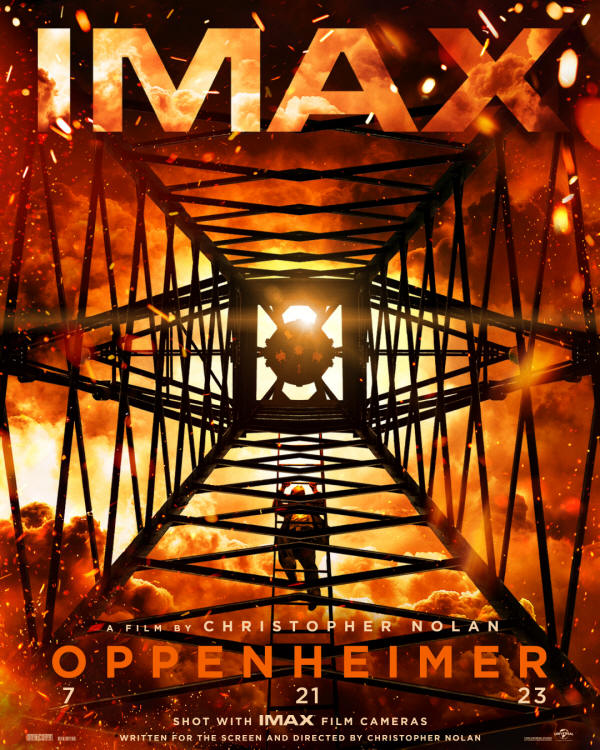 Oppenheimer marks the fourth collaboration for Christopher Nolan and
cinematographer Hoyte van Hoytema, who served as director of photography
for Interstellar, Tenet and Dunkirk, for which he received an Oscar®
nomination. Van Hoytema’s filmography also includes Her, Spectre, and
Nope. “My biggest challenge with Oppenheimer rests in the way it is very
different from the other films I’ve made with Chris,” says van Hoytema.
“In Interstellar, Dunkirk and Tenet, there’s an emphasis on action.
Oppenheimer is more like a psychological thriller; it’s reliant on the
faces of its characters.” Oppenheimer marks the fourth collaboration for Christopher Nolan and
cinematographer Hoyte van Hoytema, who served as director of photography
for Interstellar, Tenet and Dunkirk, for which he received an Oscar®
nomination. Van Hoytema’s filmography also includes Her, Spectre, and
Nope. “My biggest challenge with Oppenheimer rests in the way it is very
different from the other films I’ve made with Chris,” says van Hoytema.
“In Interstellar, Dunkirk and Tenet, there’s an emphasis on action.
Oppenheimer is more like a psychological thriller; it’s reliant on the
faces of its characters.”• “The style of photography that Hoyte and I adopted for this movie was to be very simple yet very powerful,” Nolan says. “No barrier between the world of the film and the audience, no obvious stylization other than the black-and-white sequences. But particularly with the color sequences, we wanted very unadorned, simple photography, as natural as possible, revealing lots of textures in the world. Whether it’s the costumes or the sets or locations, you’re looking for real world complexity and detail.” • Oppenheimer was shot exclusively with large format cameras—Panavision® 65mm and IMAX® 65mm. “What large-format photography gives you is clarity, first and foremost,” says Nolan. “It’s a format that allows the audience to become fully immersed in the story and in the reality that you’re taking them to. In the case of Oppenheimer, it’s a story of great scope and great scale and great span. But I also wanted the audience to be in the rooms where everything happened, as if you are there, having conversations with these scientists in these important moments.” • The black-and-white scenes required the invention of a new kind of film stock. “One of our first phone calls was to Kodak,” says van Hoytema. “We asked: ‘Do you have 65-millimeter black-and-white film?’ And of course, they didn’t, because they never made it before. So, we asked: ‘Can you make it?’” And they were like, ‘Maybe?’ And then we were always nagging them like little kids to do it. Fortunately for us, they really stepped up to the challenge. They supplied us with prototypal film stock—freshly manufactured, with hand-written labels on it—and when we tested it, the first time we saw it, it just blew us away. It was so special and so beautiful.” • The filmmaking became an ambitious experiment in producing a human-centered drama with the biggest cameras in the world. “IMAX® is usually this format for spectacle, used to present vistas and convey grandeur,” van Hoytema says. “But from the very beginning, I have always been curious to discover if it can be just as powerful when used for close-ups. Can we shoot psychology? Can we make this an intimate medium? With Oppenheimer, there has been an evolution. It was the first film where I was forced to put my money where my mouth was, so to speak, and make it happen, because the story demanded it.” • Given the large-format film and the two different kinds of stock, both color and black-and-white, the challenge of creating Oppenheimer with multiple formats continued into post-production, as the film had to be edited, color-corrected and printed for IMAX®, digital and standard presentation. |
|
THE COSTUME DESIGN |
|
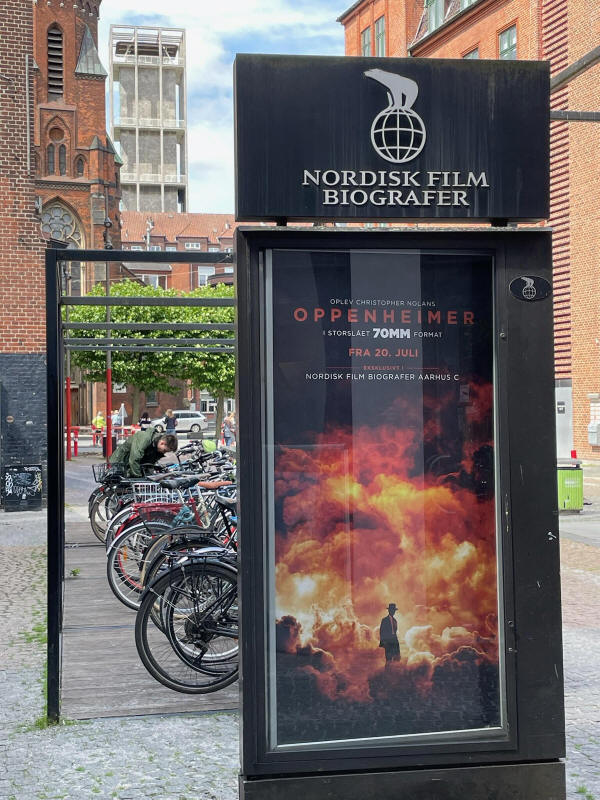 "Oppenheimer"
in "the grandeur of 70mm" at Nordisk
Film Biografer Aarhus C, Denmark. Picture: Orla Nielsen "Oppenheimer"
in "the grandeur of 70mm" at Nordisk
Film Biografer Aarhus C, Denmark. Picture: Orla NielsenWorking with Christopher Nolan for the first time is legendary costume designer Ellen Mirojnick, whose award-winning, 40-year career includes classics such as Fatal Attraction, Wall Street, Basic Instinct and Speed. “I’ve always loved Chris Nolan films,” says Mirojnick. “I love the kind of stories he tells, and I love the way in which he tells them. I love that he rips things apart and puts them back together with a surgical complexity, a surprise and a heightened panache. It’s electric! He sparks an energy that allows your imagination and curiosity to soar with limitless excitement. What I found really interesting about Oppenheimer’s story was learning how in-sync both their geniuses were in exploring an unknown landscape through the experimentation of fission and fusion, literally and figuratively.” • Mirojnick designed Cillian Murphy’s Robert Oppenheimer costumes to reflect a man whose fine tastes were clearly defined through his haberdashery. His appeal was accented by the choice of blue hues used for his shirting, illuminating his piercing blue eyes. Oppenheimer curated the same silhouette throughout his life. Mirojnick, through her research, found that his weight was the only thing that affected the silhouette, which appeared “more voluminous during the period which saw the detonation and effects of the bomb,” says Mirojnick. “His style, however, remained constant throughout.” • Key to the Oppenheimer silhouette was his hat. It took Mirojnick and her team some time to source its origin. Mirojnick reached out to hatmakers in New York and Italy to recreate the infamous shape, but it was Baron Hats, the legendary Hollywood hat maker, that recreated the hat to perfection. • Oppenheimer’s hat had distinctive lines, and Nolan knew every crease, how it folded the brim, how it shaped the crown. “Only Chris had the ability to shape it just so,” Mirojnick says. “When Chris touched it, magic would happen. He’d flip it or turn it a bit or squeeze the brim sightly to get it how he saw it in his mind’s eye.” • In contrast to Oppenheimer’s curated simplicity, Robert Downey Jr.’s Lewis Strauss was always manicured and fashionably tailored. His costumes were all bespoke. They included handmade suits, custom shirts that were initialed and ties that were exactly created from photographs. All designed exclusively to evoke his wealth, prosperity and success. • In a photo from Lewis’ Strauss Senate confirmation hearing, Strauss wore a narrow dark pin-striped suit, white shirt and a yellow tie with a dark blue, widely spaced stripe. Nolan wanted Downey Jr. to wear the same ensemble for the film’s hearing scene. Mirojnick and her team recreated every piece of clothing to match the photo, even though the scene is in black and white. • Visual reference wasn’t available for Florence Pugh’s Jean Tatlock, beyond a few headshots. So Mirojnick designed costumes for the character that spoke to her personality and the way Pugh wanted to play her. “Jean had a burning passion churning inside of her,” says Mirojnick. “We were mindful of what she would need to express the character movements.” • Emily Blunt’s Kitty Oppenheimer moves from being a Bay Area socialite and intellectual to a listless housewife marooned in the desert. To evoke a flagging, stagnating soul, Mirojnick designed an eclectic look for Los Alamos Kitty, a mashup of fashionable and casual pieces to suggest that Kitty had stopped caring about how she looked. • Mirojnick says the biggest challenge was dressing the scores of extras for the Los Alamos scenes, as it required many different types of costume pieces to help the audience quickly glean the frontier-town nature of this secret Army research lab. “There were scientists, soldiers, mothers, workers and children, of all shapes and sizes, over a period of a number of years,” Mirojnick says. “Additionally, the team were tasked with making sure each season was represented correctly whilst being mindful of the actors who were shooting outside in the cold of a New Mexico winter.” |
|
THE MUSIC |
|
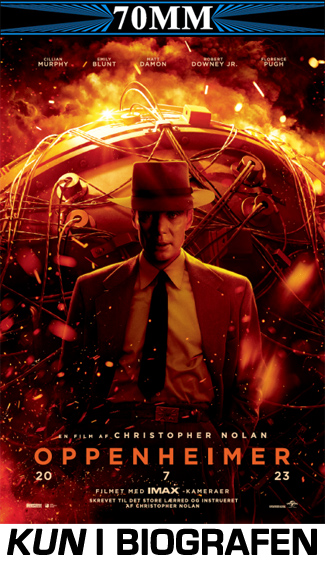 To create the score for Oppenheimer, Christopher Nolan turned again to
Oscar®-winning composer Ludwig Göransson (Black Panther films), who had
written the music for Tenet. “Ludwig’s work on the film is both deeply
personal and historically expansive,” Nolan says. “It achieves the
effect of building out an emotional world to accompany the visual world
that Ruth De Jong designed and Hoyte van Hoytema shot, and it draws the
audience into the emotional dilemmas of the characters and their
interactions with the vast geopolitical situations that they’re
confronting.” To create the score for Oppenheimer, Christopher Nolan turned again to
Oscar®-winning composer Ludwig Göransson (Black Panther films), who had
written the music for Tenet. “Ludwig’s work on the film is both deeply
personal and historically expansive,” Nolan says. “It achieves the
effect of building out an emotional world to accompany the visual world
that Ruth De Jong designed and Hoyte van Hoytema shot, and it draws the
audience into the emotional dilemmas of the characters and their
interactions with the vast geopolitical situations that they’re
confronting.”• Nolan says he had no preconceptions about the music for the film, but he did offer Göransson an idea for a starting point. “I suggested he base the score on the violin,” Nolan says. “There’s something about the violin to me that seemed very apt to Oppenheimer. The tuning is precarious and totally at the mercy of the playing and emotion of the player. It can be very beautiful one moment and turn frightening or sour instantly. So, there’s a tension—a neuroses—to the sound that I think fits the highly strung intellect and emotion of Robert Oppenheimer.” • Göransson, inspired by Nolan’s suggestion and the vivid imagery he witnessed during the early stages of pre-production, embarked on a creative exploration, harnessing the expressive potential of the violin. Driven by an unwavering desire to capture the delicate intersection between beauty and dread, Göransson’s creative endeavors manifested in an array of captivating experiments. Techniques such as the incorporation of microtonal glissandos were deftly employed to expand the sonic palette, infusing the music with an ethereal quality. Collaborating with esteemed musicians from the Hollywood Studio Orchestra, Göransson began shaping Oppenheimer’s musical world with an intimate solo violin performance, capturing the essence of the character. As the story evolved, the ensemble gradually expanded to include a quartet, octet, and ultimately a large ensemble of strings and brass. This progressive orchestration reflected the deepening complexity of Oppenheimer’s journey, enriching the musical tapestry with each new addition. • Throughout the early stages of his composition process, Göransson was steadfast in his commitment to preserving the organic essence of the violin and strings, opting not to rely heavily on modern production techniques. “The heart and the heartbeat of the music is all driven by an organic orchestra, with a human touch to the music,” Göransson says. • In addition to Oppenheimer’s theme, other musical motifs associated with specific characters and themes followed the same ethos. For instance, Kitty Oppenheimer and the Robert-Kitty romance were underscored by a haunting piano melody. As the score progressed, Göransson found strategic opportunities to introduce more contemporary production elements. Notably, synthesizers were employed to symbolize the impending doom and haunting consequences of Oppenheimer’s creation, creating an otherworldly atmosphere for the Los Alamos motif. • During the post-production phase of the film, the recording of the score came together during an intense 5-day period. Göransson, inspired by his artistic vision, pushed both himself and his fellow musicians to the very limits of their technical abilities. Notably, the montage sequence featured a complete, unbroken recording that proved immensely challenging to achieve, requiring numerous iterations and dedicated efforts to perfect. |
|
THE VISUAL EFFECTS |
|
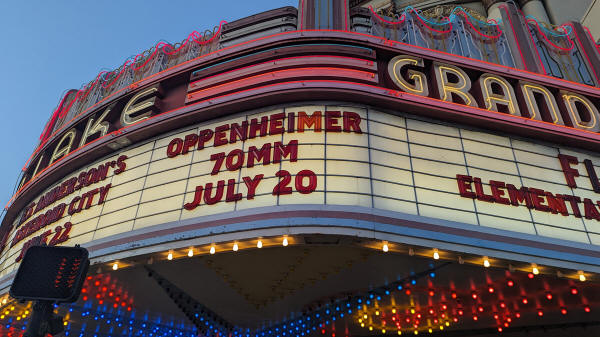 "Oppenheimer"
in 70mm at the Grand Lake in Oakland, CA. USA. Picture: Casey Foster "Oppenheimer"
in 70mm at the Grand Lake in Oakland, CA. USA. Picture: Casey FosterContrary to Internet rumor, Christopher Nolan did not detonate an actual atomic bomb in New Mexico for Oppenheimer, just so he could film the nuclear fire and mushroom cloud of the iconic Trinity test. Instead, Nolan and cinematographer Hoyte van Hoytema worked with special effects supervisors SCOTT FISHER (a Nolan vet who won Oscars® for Interstellar and Tenet) and ANDREW JACKSON (who also won an Oscar® for Tenet) to produce the film’s version of atomic explosion. Nolan gave them a limitation: Consistent with his aesthetic preference for practical effects, Nolan told them there could be no computer-generated imagery. “I knew from the beginning that the Trinity test was going to be one of the most important things for us to figure out,” says Nolan. “I had done a nuclear explosion via computer graphics in The Dark Knight Rises, which worked very well for that film. But it also showed me that with a real-life event like Trinity, which was well documented using new cameras and formats developed for recording that event, computer graphics would never give you the sense of threat that you see in the real-life footage. There’s a visceral feeling to that footage. It becomes tactile, and in becoming tactile it can be threatening as well as awesome. So that was the challenge. To find what you might call analog methods to produce effects to evoke the requisite threat, awe, and horrible beauty of the Trinity test.” Jackson and Fisher began conducting experiments—smashing ping pong balls together, throwing paint at a wall, concocting luminous magnesium solutions, and more—and filming them on small digital cameras super close-up at various frame rates. “Then we’d show it to Chris,” says Fisher, “and he’d say, ‘Yeah, that’s the right idea. Now figure out how to shoot it massive with IMAX® cameras.’” (That work required developing a long, fish-eyed probe lens that could be attached to IMAX® and Panavision® cameras.) How the actual atomic explosion images were created for the film remains top-secret, but it’s clear the work of making them was a Manhattan Project unto itself, and a rather fun one, too. “Their whole unit was one, big science project,” says van Hoytema. “I was very jealous that they got to play around so much with all that kind of stuff.” Some of the techniques that Nolan’s f/x team used to produce the spectacle of nuclear fission were also used to help create the scenes that portray Oppenheimer’s inner world. Again, Nolan placed a premium on practical effects and eschewed CGI. “There’s one sense in which computer graphics is the obvious way to do it, but I didn’t feel we were going to get anything that would feel personal and unique to Oppenheimer’s character,” says Nolan. “We were able to generate this incredible library of idiosyncratic and personal and frightening and beautiful images to represent the thought process of somebody at the forefront of the paradigm shift from Newtonian physics to quantum mechanics, who is looking into dull matter and seeing the extraordinary vibration of energy that’s within all things, and how it might be unleashed, and what it might bring.” |
|
 • Go to "Oppenheimer" Production Notes |
|
| Go: back - top - back issues - news index Updated 22-01-25 |
